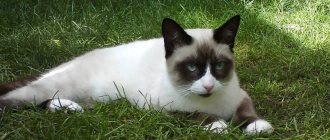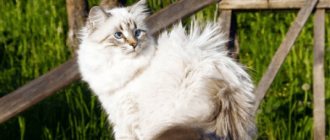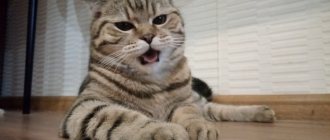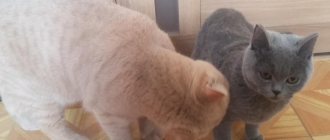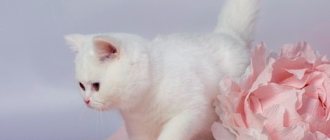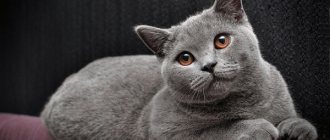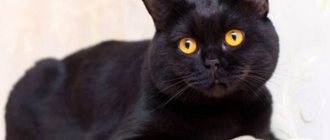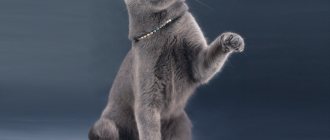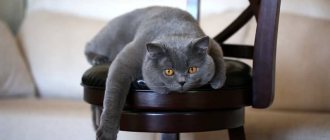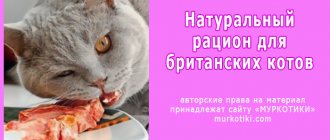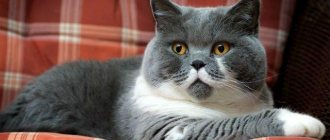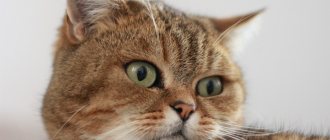The British Fold cat is the result of crossing a purebred British and Scottish cat. The first of them has predominantly cobby-type features, which is expressed in a stocky build with massive legs, rounded shapes and thick hair. While Scottish Folds have a more graceful build and characteristic hanging ears.
The Fold-Eared Briton combines the distinctive characteristics of both representatives, but due to the peculiarities of breeding, it cannot have a pedigree. However, such a kitten will become not just a pet, but also a member of the family with its own character and habits, which will be discussed further.
Unofficial breed
Everyone knows the Scots precisely because of their characteristic feature - forward-curved ears, slightly hanging down in the direction of their gaze. They add incredible charm and recognition to the pet, and also cause affection among the owners.
The first mentions of such pets were found in China, and in Scotland they became popular only in 1959 thanks to William Ross and his farmer neighbor. It was they who decided to give rise to a new breed, but further research showed that the lop-eared gene weakens the animal’s cartilage.
Crossing purebred Folds with each other caused serious musculoskeletal problems in the offspring, which became the basis for banning their breeding.
Therefore, breeders began to combine fold-eared cats with straight-eared cats, for which the British and Americans with short hair were excellent. This made it possible to almost completely eliminate the defect and obtain Scottish Folds with hanging ears and Scottish Straights with straight ones. Mating them together produces a varied but healthy litter, which breeders use to this day. This breed spread to Russia at the end of the last century.
Straight-eared British cat, not to be confused with fold ears
After breeding the Scottish Fold, experiments were carried out to cross the British with them, and as a result the British Fold was obtained. This is a conditional name, since they were bred not so long ago and were not registered by the International Felinological Association. Due to this origin, there can be no talk about the purity of the blood or pedigree of the pets.
In addition, they differ from purebred Scots in their stocky, powerful body, and from the British in the shape of their ears.
Mr Cat explains: the difference between the British and the Scots
To know the characteristics of the British Fold, it is worth considering the characteristics of the breeds that gave it life - Scottish and British Shorthair.
| Sign | British | Scotsman |
| Ears | Wide, erect, slightly rounded at the tips. | Narrow straight, slightly curved or close to the head. |
| Body structure | Stocky, powerful and squat. | Graceful and embossed, the bone is narrower. |
| Head | Oval, with developed cheekbones and prominent cheeks. | Rounded, with a strong chin and strong jaws, smaller cheeks. |
| Neck | Short, with a fold. | Middle length. |
| Paws | Massive, short. | Slender, proportional to the body. |
| Tail | 2/3 of the length of the body, thick, tapering and rounded towards the end. | Mobile, long, medium thickness. |
| Wool | Plush, short, thick and smooth. | Fluffy, medium to long. |
| Weight | 5-8 kg. | 3-5 kg |
| Character | Discreet and calm, independent, devoted. | Kind and friendly, inquisitive, playful. |
| Health | Strong, good immunity. | Careful care is required, especially for the ears. |
| Peculiarities | Love of heights, lack of the habit of sitting, tendency to loneliness, aristocratic behavior. | Sitting on the butt, standing upright, tendency to learn, ease of adaptation, fear of heights. |
| Crossing | Only within the breed. | Between two types - folds and straights. |
Thus, the outwardly massive British can be distinguished from the Scottish not only by the shape of the ears, but also by other characteristics.
Moreover, when choosing a pet, you should pay attention to its character - a representative of the first breed will be an ideal option for workaholics who spend little time at home. Whereas the affectionate Scot is much more suitable for people with families, with small children and a gentle disposition.
More about the price
Representatives of the British Shorthair breed get along well with people of all ages, including small children (cats are not jealous). The average price in Russia for such a faithful friend ranges from 2,500-10,000 rubles . If we are talking about buying a kitten in a nursery or from titled parents, then the cost can reach 30,000 rubles .
In any class, kittens may cost more or less. Color plays an important role in this matter. Chocolate and lilac British Shorthair cats are very common, so they are relatively inexpensive. Breeding kittens of this color is not difficult. It’s a different matter if we are talking about a chinchilla with green eyes or blue-eyed color-point animals. Their price is significantly higher.
Remember that a good British Shorthair kitten cannot be cheap. You should take into account at a minimum the costs of mating, special food for a pregnant cat, food for kittens, diapers, toys, vaccinations, and documents.
More details: https://www.kakprosto.ru/kak-824881-skolko-stoit-kotenok-britanca#ixzz4AFN6H1OG
Description of the breed, behavioral characteristics
A British Fold cat will look like a teddy bear with folded ears. That is, he takes over most of his features from his British relative - plump cheeks on a rounded head, a stocky body with short legs, stuffed soft fur. The color can be any, although gray-blue representatives are more common, and in large eyes a honey tint predominates.
He absorbed a lot from the folds, in particular, drooping ears, flexibility of the body and basic habits. So, each animal has its own habits and behavioral characteristics, individual, but something common will appear in them:
- The “column” position while sitting on your butt or standing on your hind legs with a straight back looks very amusing and funny. Few people know that it allows you to straighten the vertebrae and stretch your back, so it is rather a necessity.
- The absence of jealousy towards other animals, a friendly attitude towards everyone allows him to be kept in the same house even with dogs. It is thanks to his friendliness and playfulness that he becomes a favorite among children, and his obedient and gentle disposition will delight older people.
- A considerable appetite can lead to problems with the pet’s weight, which should not be allowed. In a cat over 3 years old, it can reach 8 kilograms, while female cats are usually smaller. To avoid pathologies, you should feed him 3-4 times a day, carefully dosing the food.
Wool problems 2 times a year
Combing
Cats that take their pedigree from England need to be brushed once a week in the direction of hair growth and against it. This will require special tools: a metal comb or a massage brush. Fortunately, the British enjoy combing and patiently endure the combing procedure.
Shedding in cats is usually seasonal - in spring and autumn. If the pet lives in apartment conditions, where the temperature is mostly stable in winter and summer, then shedding may go unnoticed. There is a disclaimer here regarding pet care. If he does not receive enough vitamins, eats monotonous food, and moves little, then there is a risk that molting will become a real problem for the owner. In addition, this may indicate health problems.
A cat who has recently given birth to kittens may have shedding hair. The stress factor also affects the condition of the long-eared fur coat, because it is directly related to health.
Shedding
Housing conditions, in particular feeding and temperature conditions, affect the duration of molting. On average it lasts 3-5 weeks. During this period, you can remove excess fur with wet hands or a rubberized mitten, sold in every pet store.
Description of character
Despite the differences between the British Fold and his ancestors from essentially different breeds, he took the best - incredible friendliness and affection for his owners, balanced disposition and calmness. He loves games, but he never imposes himself, and is also easy to basic training.
To get an obedient pet with a gentle disposition, the owner is required to give up unreasonable aggression and rudeness towards him.
"Lop-eared" becomes attached to the owner
This cat loves to eat, which may be why she quickly becomes attached to the person who feeds her. Therefore, it is advisable that the owner himself does this if he wants to receive devotion and obedience in response to care and affection.
Such a pet is independent and self-sufficient, and is considered an ideal option for a person who is busy at work for a long time.
So, he can remain alone for a long time, but he will always happily meet the person to whom he is attached.
In addition, the cat loves to just sit next to the owner or work with a claw sharpener, and if necessary, he will easily support the game he has started. But at the same time he never sits in his arms and does not tolerate hugs.
Temperament
Like the Scottish Fold, the British Fold is very inquisitive and gentle. Therefore, the maximum that you can get from him in case of dissatisfaction is a loud cry and a dissatisfied look.
It is also worth remembering that a long flexible tail is a pet’s special pride, and, in his opinion, always requires careful handling.
The British is clean and always looks respectable, which should also be remembered. That is, you need to be prepared for the fact that it will require constant attention from a person.
He is very independent and independent, requires personal space and respect from people. Without receiving anything, he will begin to show his dissatisfaction, which will lead to problems in mutual understanding.
In general, a cat can be either calm and balanced, or active and restless, which manifests itself in each individual case in its own way.
Pride in such a representative of the family can be combined with playfulness, and gentleness of character with an interest in hunting and tracking down the intended prey.
Relationships with other household members (children and dogs)
The behavior of the Fold remains friendly to everyone; he does not perceive aggression from the outside and does not show it himself. He gets along well with dogs and other pets. He dotes on children, playing with babies and cuddling with them for hours or falling asleep next to the child. Also read the article about the best cat breeds for children.
The main rule here is not to touch the tail and not to offend it in general, otherwise the cat will simply run away, maybe even leave the house.
In some cases, teeth and claws can be used against adults, but such a negative attitude will manifest itself immediately, because they do not know how to harbor a grudge. We recommend reading the article about breeds prone to aggression.
How long do British cats live?
Like other felines, British cats live for about 15 years. True, this indicator is influenced by many factors:
- Attentiveness and care of the owner
- Conditions of detention
- Nutrition
- Heredity
- Past illnesses
- Other reasons
Loving owners dote on their pet, and therefore pamper it with treats. Such “care” can provoke obesity. With such a diagnosis, a cat will not live that long - up to 10-12 years. A good owner who took proper care of his pet and followed all the veterinarian’s recommendations can have a cat that can live for 2 decades.
Those who want to see a familiar warm lump next to them longer should castrate or sterilize the animal, because this has a positive effect on its life expectancy. Since cats, just like people, are susceptible to cancer, this operation significantly reduces the risk of malignant tumors.
- Urban dog breeds
- Origin of the cat
- Hypoallergenic dogs
- Fighting dog breeds
- The rarest cat breeds
- German Shepherd
Colors
The luxurious plush coat of the British Fold is always stuffed and soft to the touch, and thanks to the cleanliness of this breed, it is always shiny and looks well-groomed. At the same time, kitties have a neat and gentle appearance, while cats can be slightly disheveled.
Colors can take on a wide variety of shades and patterns, including:
- Single color solid. Gray-blue representatives are more common, although some have fur that can be red, black, grey, brown, lilac, and less commonly white or peach.
Solid white
- Striped, marbled or spotted colors are indicated by adding the word "tabby" to the base color. At the same time, on a lighter base there are dark stripes, stains or spots that form the letter “M” on the forehead.
Tabby
- A smoky shade appears when each hair is colored only a third of the main color, and a chinchilla shade - if it is an eighth. The rest of the fibers may be silver or white. Also read the article about the British chinchilla.
Chinchilla shade
- The Siamese Colored has a light body with darker limbs. Thus, chocolate or almost black paws, tail, ears and muzzle stand out against a cream background.
Siamese Colored
- Tortoiseshell coloration is often black with splashes of different shades of red. Sometimes cream can be combined with gray or brown.
Tortoiseshell coloring
- Bicolor has two colors - white with blue, chocolate, black. Light in the lower part of the body, combined with tortoiseshell at the top, forms the “calico” color, characteristic of Scottish cats.
Color Bicolor
GOLDEN BRITISH: TYPES OF GOLDEN COLOR BRITISH CATS
The British golden color comes in the following types:
- shaded;
- veiled;
- tabby (ticked, spotted, striped, marbled).
The veiled, shaded and ticked color of the British is also called chinchilla.
| Golden veiled color of British cats | Golden shaded British kitten | Golden ticked British cat |
| Golden spotted British cat | Golden tabby (brindle) color of the British | Golden marbled British kitten |
Maintenance and care
The British Fold does not require special attention, since he gets used to looking after himself from an early age, repeating the movements of his mother. But still its content implies:
- regular feeding with either dry food or natural products, and always a full drinking bowl;
- cleansing the ears of wax, dirt and other accumulations, at least once every 2 weeks, using a special liquid and cotton swabs;
- combing the undercoat with special brushes at least once a week, and for a long-haired pet - at least three times, possibly against the grain;
- daily removal of dark discharge from the corners of the eyes with a napkin soaked in boiled water;
- cutting the claws every 3 weeks by 2-3 millimeters with a nail clipper and scratching post, examining them against the light to avoid getting on the vessel (only for cats that do not go outside);
- examination of the ears for rashes and eyes for purulent discharge, in which case you should visit a veterinarian;
- bathing no more than once every six months if there is an urgent need for warm water, the temperature of which does not exceed +40 degrees.
In addition, from an early age it is important to allocate personal space for the kitten, arrange a toilet and a place to sleep, and install a claw sharpener. Then he will quickly get used to the new housing and owners.
Proper care includes a balanced diet, 2-3 times a day in small portions.
A mixed diet is not recommended for this breed, that is, you should give the cat either ready-made food or natural products:
- lean meats - raw beef or turkey, boiled chicken, boneless and skinless fish;
- milk, fermented milk products and cottage cheese, less often you can pamper your pet with cream or sour cream, but not more than 2 times a month;
- oats, millet, rice can be cooked in broth with the addition of meat;
- cabbage, cucumbers, carrots and zucchini will fill the body with vitamins.
BRITISH GOLDEN KITTENS
British golden kittens are born bright, with clearly visible gold; the tone of gold, if it changes, is insignificant, but the pattern on the coat may become more contrasting over time or, on the contrary, fade. The color is fully established by about a year. The green eye color of golden Britons is fully formed only by 2-3 years.
| In our cattery you can “buy a real British kitten.” We have many different colors, we will help you choose and answer all your questions! |
Health, reproduction, kittens
British Folds were created through crossbreeding, so they can be quite sickly.
In particular, they have a high risk of developing the following pathologies:
- Deformation of cartilage in some individuals affects not only the shape of the ears, but also the entire spine. Therefore, they may experience fusion of the vertebrae, shortening of bones and thickening of joints, and the appearance of bone growths, which can only be corrected surgically.
- Hypertrophic cardiomyopathy (HCM) is a genetically determined uneven thickening of the interventricular septum and ventricular walls. Progresses to heart failure with chest pain. The disease makes itself felt in individuals after a year and is detected by ultrasound.
- Obesity. Due to a good appetite, if you do not monitor your pet’s nutrition and activity, it can gain excess weight quite quickly. This in turn will lead to many health problems. A proper diet, outdoor games and plenty of space in the house or yard increases his activity and reduces the risk of illness.
- Worms, fleas and other parasites come from the outside, are absorbed with food or hairballs when licking, especially if the cat is in contact with other animals. Now there are many means to get rid of them, which are best used as prescribed by a veterinarian.
- Infectious diseases. These are immunodeficiency, aspergillosis with chronic runny nose, calcivirosis and rhinotracheitis. And especially life-threatening peritonitis, panleukopenia, leukemia, rabies, tuberculosis. To prevent them, vaccinations are necessary: annual against rabies starting from the age of 8 months, and others no later than the three-year period when maternal immunity is still in effect.
On average, adults live from 14 to 20 years if you monitor their condition.
For example, periodically lifting an animal by its front legs reduces the likelihood of developing spinal pathologies. Timely and proper care will avoid many other problems.
Particular attention should be paid to the issue of breeding pets. If owners want to get healthy offspring, under no circumstances should individuals with the same gene be crossed when both of them have drooping ears.
It is worth taking individuals with straight and curved ears, it is better if both of them belong to the British breed. And after 9 weeks it will be possible to get a mixed litter, but the likelihood of their mutation is significantly reduced.
The peculiarity of lop-eared cats is that they are all born with erect ears. They acquire their shape only on the 21st day, then it will be clear which of the babies will be straight-eared and which will be a typical representative of the British breed.
The owners will only have to choose suitable nicknames, remembering that the British are proud and independent animals, and they will serve their family faithfully.
Reviews of British cats
Kristino4ka
There is a universal favorite in our family - a blue British shorthair cat - Vikusya. We bought her at a Moscow nursery. We followed her by train. She has an excellent pedigree and excellent breed characteristics. She is only two years old.
The first advantage that pleasantly surprised me was extreme cleanliness. She always goes to the toilet in a specially designated place. There are no problems with this at all!
Vikusya is very smart and loves to talk to us. When you tell her something, she looks into your eyes and responds with intermittent meows. From the outside it looks very funny!
The cat is calm, affectionate, and loves to sleep. Therefore, it is ideal for those people who are at work from morning to evening. The cat will not be bored; it will definitely keep itself busy with something. In the summer he likes to sleep on his back, with his legs spread wide in different directions.
If Vikusya wants to eat, she will never scream and ask for a tasty morsel. He sits next to him and watches. Unpretentious in food. He eats dry food, about which I previously wrote a detailed review. Loves beef, veal and shrimp.
Loves to play with a toy mouse and skeins of yarn.
Sometimes it accelerates and jumps on the wall, pushing off from it with its hind legs. In some ways it reminds me of The Matrix.
